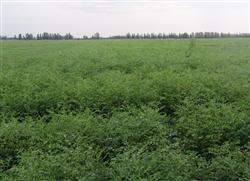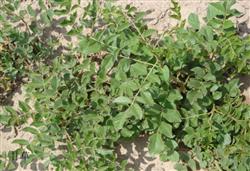Market prospect and scientific planting of licorice

Benefit Analysis and Market Prospect Glycyrrhiza uralensis is a perennial herb of Leguminosae, which is used in medicine with roots and rhizomes. Sweet in taste and flat in nature. Licorice is the king of traditional Chinese medicine, and the Compendium of Materia Medica lists it as the first of all medicines. It has a wide range of uses. The underground part of licorice has the functions of clearing heat and detoxification, moistening the lung and relieving cough, relieving thirst and expectoration, tonifying spleen and stomach, reconciling various medicines and so on. The prescription of traditional Chinese medicine is inseparable from licorice, commonly known as "ten prescriptions and nine herbs". The acid drugs of licorice have the effects of preventing and treating viral hepatitis, hyperlipidemia, anti-cancer and regulating human cellular immune function. The aboveground part of Glycyrrhiza uralensis has high content of crude protein and crude fat, low content of crude fiber, stems and leaves contain a variety of trace elements needed by animals, the feeding effect is similar to that of alfalfa, and its output reward is slightly higher than that of alfalfa. It can be used as an excellent legume forage. Artificial cultivation of licorice has attractive business opportunities, and the market demand and export volume are increasing day by day, so it is still a godsend opportunity to develop licorice in the next few years. The main reasons for the rising price of licorice are as follows: first, there are a large amount of medicinal materials and a wide range of uses. Second, over the years of predatory mining, so that wild licorice in the stage of extinction. Third, licorice needs to grow for 2 ~ 3 years (including seedling growth period) before it can be harvested, and many people dare not plant it for fear of falling prices after planting. This fully proves that it is imperative to develop artificial cultivation of licorice. According to the statistics of the national customs, after China's accession to the WTO, the export volume of licorice has been increasing, and the export raw materials have been gradually transformed into semi-finished products. Therefore, licorice is widely used in medicine, food, beverage, chemical industry, brewing and national defense construction and other industries. Planting management and harvesting technology growth habits: Gansu grassland wild in the desert, semi-desert steppe, is a strong alkali-resistant plant. Distributed in the continental climate zone, when its roots form Lignification, it is resistant to drought, flood, cold, light and cool and dry climate. The requirements of the soil are not strict, and the general soil can be planted. It is especially suitable for newly reclaimed barren mountains and hills, and is preferably used for some large land contractors. Propagation methods: the seeds treated by scientific methods can be directly sown or nurtured and transplanting. Sowing time and transplanting: spring sowing: March-April; summer sowing: May-July; autumn sowing: before White Dew. No matter what month the seedlings are raised, they can be transplanted to the field before and after the Spring Festival, with about 12000 seedlings per mu. Transplanting: after the land is leveled, press 40cm line spacing, plant spacing 15~18cm, deep 8cm, flat load in the ditch, cover with soil. Fertilization and soil preparation: urea 20 kg / mu, potash fertilizer 20 kg / mu, calcium superphosphate 50 kg / mu or compound fertilizer 50 kg / mu, and then apply low residual pesticides to kill underground insects. 30cm deep turning the ground, raking fine leveling, direct seeding to make a high border 60 cm wide, raising seedlings to make a 120 cm wide high border. Harvest and processing: licorice is put into medicine by root, which can be harvested before sprouting in October to December or spring, and can be planted in a large area. It can be detected manually after ploughing on a 50 tractor. After harvesting licorice, cut off the stems and branches, dig out the roots, clean the soil, chop off the Reed head, branches and fibrous roots, sun to half-dry, into small bundles, and then dry to sell. The quality is better if the skin is red and pink and the taste is sweet.
- Prev

Morphological characteristics and suitable planting environment of Glycyrrhiza uralensis
[morphological characteristics] Glycyrrhiza uralensis is a perennial herb with a height of 30cm and 100cm. Covered with white pubescence and glandular hairs. Aboveground stems erect, lower lignified, branchlets angular, green. Leaves alternate, odd status compound leaves. Leaflets 3-8 pairs, ovoid or ovate-elliptic, entire, apical leaflet larger. The general situation.
- Next

Harvest and processing of licorice
The key technical measures of high-yield cultivation were to plant in sandy loam soil with fertile soil, loose texture and good drainage. The seeds are treated before sowing to improve germination rate, watered at seedling stage to protect seedlings, and applied with sufficient phosphorus and potassium fertilizer in early spring every year. Harvesting and processing 1. Harvesting licorice propagated with seeds generally grows after sowing 4.
Related
- Fuxing push coffee new agricultural production and marketing class: lack of small-scale processing plants
- Jujube rice field leisure farm deep ploughing Yilan for five years to create a space for organic food and play
- Nongyu Farm-A trial of organic papaya for brave women with advanced technology
- Four points for attention in the prevention and control of diseases and insect pests of edible fungi
- How to add nutrient solution to Edible Fungi
- Is there any good way to control edible fungus mites?
- Open Inoculation Technology of Edible Fungi
- Is there any clever way to use fertilizer for edible fungus in winter?
- What agents are used to kill the pathogens of edible fungi in the mushroom shed?
- Rapid drying of Edible Fungi

